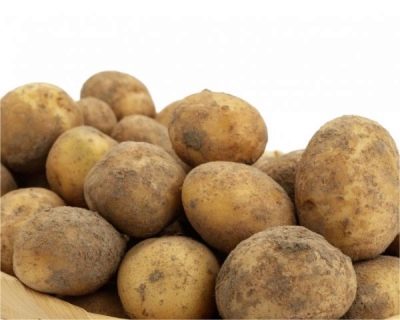
- Authors: Folk selection
- Appointment: dining room
- Tuber size: small
- Tuber weight, g: 120-200
- Peel color: yellow
- Color of the pulp: white
- Starch content,%: 13-17%
- Tuber shape: rounded
- Peel structure: thin
- The soil: sandy and black earth
The Borovichok variety of folk selection is the owner of weighty and mouth-watering tubers. It is not included in the State Register of Varieties and does not pass tests, however, like any result of national selection, it has interesting characteristics.
Description of the variety
Borovichok attracts with the balance of characteristics. It has classic tubers, with a golden skin and a versatile white flesh that suits all dishes. Such potatoes are usually poorly stored, but Borovichok lies perfectly until spring. The variety feels great in the south of the Russian Federation, disease-resistant, unpretentious and very productive.
Characteristics of the appearance of the bush and root crops
The bush is compact, powerful, of medium height, up to 60 cm, with straight branches. Leaves are medium, dark green in color with barely noticeable waviness at the edges. The cultivar grows tops with moderate activity. The flowers are large, white or milky, and fade very quickly.
Tubers are round, medium in size - 120-200 grams, medium calibration. With early planting, it can form a lot of small things, when planting in warm soil, the caliber of the tubers is good, at least 10 large fruits are formed under the bush. The skin of the tubers is complex yellow, thin, but strong and dense, the flesh is white. In appearance, the tubers resemble the caps of boletus mushrooms, which is why the variety got this name. The starch content is 13-17%, these are average values.
Purpose and taste of tubers
Table variety. Taste - excellent or good, very pleasant, delicate and full-bodied. Culinary type - BC, such tubers are quite dense, suitable for frying, soups, baking, but they are able to boil moderately - suitable for making creamy airy puree.
Maturation
The variety is early, ripens 70-90 days after planting. A well-warmed soil in spring and a favorable summer - warm, sunny, with sufficient rainfall - contribute to the acceleration of ripening.
Yield
One bush gives 9-14 tubers. The maximum yield is 250 c / ha, but on average, 200 c / ha are harvested. The tubers have excellent keeping quality - 94% of the harvested crop survives until spring without damage.
Growing regions
The variety is hardy and versatile; it grows in any regions of the Russian Federation. Shows the best yield in the south, takes a hot climate well.
Growing and care
The culture tolerates drought and heat well, loves warm sunny places, airy soils. In warm regions, 2-3 harvests are obtained per year. For maximum yields, drip or manual irrigation is organized, at least 1 time per week during periods of hot dry weather. When watering, the soil should be 40-50 cm wet.
Otherwise, the care is standard: planting in well-warmed soil in May, up to 2-3 hilling per season. Before planting, it will be useful to soak the tubers in a growth stimulator or a weak solution of potassium permanganate. A little humus and wood ash are poured into the holes. After planting, it is advisable to mulch the row spacing with straw.
Potatoes do not need feeding, but they will gratefully accept the introduction of potassium-phosphorus fertilizers into the soil 1 time per season.
1 week before harvesting, the tops of the plants are cut off.
The variety can suffer from late blight, however, due to early maturity, it rarely gets sick - when the causative agent of the disease from the genus of fungi begins its activity, the Borovichk harvest has already been harvested.
Borovichok is suitable for growing according to the Dutch technology - on the ridges. It is very responsive to even warm temperatures, and the ridges allow it to provide just such conditions.It can also be grown by any non-traditional methods: in bags, under straw or hay, under cardboard, in barrels, boxes, boxes.
Such methods eliminate the need to fight weeds, there is no need for watering and hilling.

Planting potatoes is one of the main spring activities traditional for Russian gardeners. There are many ways to plant this vegetable, allowing you to get a good harvest in different conditions and climates. Before planting, you need to carefully prepare the planting material, correctly determine the timing, competently prepare the soil.


Soil requirements
The variety, like any potato, prefers loose and fertile soil. The best soil types are black soil, sandy soils, sandy loam. Loosening components are added to clayey, heavy and dense soils: coarse-grained sand, peat, well-rotted humus, rotted sawdust, very fine gravel, chopped straw. In the intervals between plantings, siderates are sown: mustard, phacelia.

Disease and pest resistance
Borovichk's resistance to the underlying disease, late blight, is average. But he has excellent immunity to viruses, golden nematode, potato cancer.

Potatoes are a popular vegetable crop that many gardeners planted on their site. But growing a bountiful harvest of tasty and large tubers is unlikely to succeed if the beds are not properly protected from the most common diseases and pests. Often, the development of diseases of various etiologies of potatoes goes unnoticed, so it is important to identify the problem in time and eliminate it.
Review overview
The variety is inferior in yield to the best German, Dutch or Russian varieties, it is picky about the nutritional value of the soil and can form a lot of fines. However, it is very attractive for its early ripeness, delicate, tantalizing appetizing taste, disease resistance and keeping quality. It does not require complex agricultural techniques, it allows you to experiment. The variety is willingly grown in small farms for themselves and for sale.
















































































